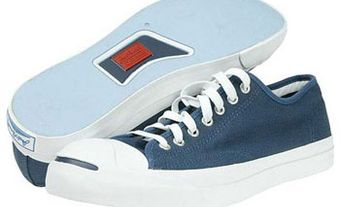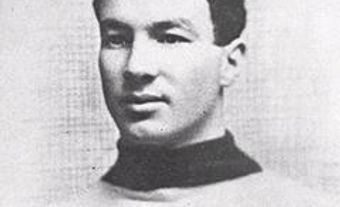
Family and Business
Harold Ballard was born Edwin Harold Ballard but was called Harold as a boy and would later reverse his names, calling himself Harold E. Ballard. He was the only child of Sidney Eustace Ballard and Mary (Manie) Garner. Sid Ballard had been born in England but came to Canada as an infant. He grew up in Paris, Ontario, and later worked in local mills, becoming a skilled mechanic and machinist. By the turn of the century, he and his brothers had moved to Toronto, where Sidney was employed by the Eastman Machinery Co. Sidney, Mary (whom he married in 1898) and young Harold lived on Sherbourne Street, not far from where Maple Leaf Gardens would eventually be built.
In 1905, Sid Ballard moved his family to Rochester, New York. Soon after, they relocated to Norristown, Pennsylvania, where Sid and two of his brothers worked for a company producing knitting and sewing machines. By 1911, Sid Ballard had moved his family back to Toronto where he set up his own business, the Ballard Machine Co., which made ice skates as well as equipment for Toronto’s garment industry. The company became very successful and made the family wealthy. Sid Ballard was a millionaire when he died in 1936.
Harold Ballard attended high school at Upper Canada College, but dropped out in 1919 at age 16, halfway through his third year. It was the end of his formal education. He began to work for his father’s company, which was turned over to his control in 1935, a year before his father’s death. Harold ran the family business successfully until the 1970s.
In November of 1941, Harold Ballard married Dorothy Higgs, whom he’d known since 1924. They had three children: Mary Elizabeth, Bill and Harold Jr. After Dorothy died in 1969, Ballard’s relationship with his children deteriorated. The family did not get along with Ballard’s late-in-life companion, Yolanda MacMillan, who called herself Yolanda Ballard although she and Harold never married.
Early Sports Involvement
Harold Ballard competed as a speed skater in Toronto in the 1920s. His competitive career was not as illustrious as he would later boast, but his appearances at events helped him to promote the Ballard skates produced by the family company. He also got to know many of Toronto’s hockey players. In 1928, Ballard paid his own expenses to attend the Olympic Winter Games in St. Moritz, Switzerland, where he was trainer and helped take care of the equipment of the gold medal–winning Varsity Grads hockey team. He also carried the banner identifying Canada at the parade that opened the Olympics.

By the summer of 1929, Ballard was racing hydroplane boats known as Sea Fleas for Toronto’s National Yacht Club (NYC). That winter, the NYC entered a senior team in the Ontario Hockey Association. By 1931–32, the National Sea Fleas were Allan Cup champions as the best senior team in Canada. Ballard had helped to run the team’s business operations and reluctantly took over as coach the following season. The Sea Fleas struggled in 1932–33, but Ballard salvaged the season by arranging a tour of Europe. The Sea Fleas took part in the 1933 World Championships in Prague, but became the first Canadian team to settle for silver at a major international tournament when they were beaten 2–1 by the United States entry in the gold medal game. There were several incidents both on and off the ice during the Sea Fleas’ European tour. Ballard was arrested after a dispute at a Paris restaurant, but when the team got home they claimed that most of the stories of their adventures had been exaggerated.
Before the 1933–34 season, the National Sea Fleas merged with the West Toronto hockey club to become the West Toronto Nationals. Ballard ran the organization’s business operations. In 1935–36, the West Toronto junior team won the Memorial Cup. Ballard ran the team along with Leafs star Hap Day, who served as coach. A year later, Ballard and Day led a senior team sponsored by the Dominion Brewery of Toronto, which was owned by E.P. Taylor, to the Ontario provincial finals.
Toronto Marlboros
Ballard had long wanted to get involved with the Toronto Maple Leafs organization, beginning in the 1930s. He finally got his chance in 1940 when he was appointed president and manager of the Toronto Marlboros, whose senior and junior hockey teams were owned by the Maple Leafs. Ballard’s friend Stafford Smythe, the son of Leafs founder Conn Smythe, played for the Marlboros junior team under Ballard in 1940–41 before enlisting in the Navy for the Second World War. In 1947, Stafford Smythe joined Ballard as coach of the Marlboros juniors. Soon, Ballard was running the senior team while Smythe ran the junior team for him as well as overseeing all of the organization’s youth hockey programs. The Marlboros seniors won the Allan Cup in 1950, while the juniors won back-to-back Memorial Cup titles in 1955 and 1956.
Toronto Maple Leafs
In the fall of 1957, Conn Smythe stepped back from the day-to-day running of the Toronto Maple Leafs. Stafford Smythe headed up a new seven-man management committee that also included John Bassett. Harold Ballard became part of the so-called “Silver Seven” that November when he took over from one of the original members. Four years later, in 1961, Stafford Smythe, Bassett and Ballard bought control of the Maple Leafs from Conn Smythe.
Ballard had little to do with the day-to-day hockey operations during the Maple Leafs’ most successful period, which included four Stanley Cup championships between 1961–62 and 1966–67. His responsibilities had more to do with off-ice events and promotions, including concerts and boxing matches. Ballard famously put up advertising inside Maple Leaf Gardens (which Conn Smythe had long considered crass) and removed a portrait of Queen Elizabeth in order to add more seats.

In 1969, Ballard and Smythe were charged with tax evasion and with using Maple Leaf Gardens funds to pay for personal expenses. Still, they were able to buy out Bassett in September 1971. When Stafford Smythe died in October shortly before his case went to court, Ballard gained control of the team. By February 1972, he’d bought up Smythe’s shares and become the principal owner of the Maple Leafs, although he would serve a year in prison beginning in the fall of 1972.
With the creation of the World Hockey Association (WHA) in 1972, the Maple Leafs lost many promising young players to the rival new league. Ballard was not the only NHL owner who failed to take the WHA seriously, but his outbursts against some of the remaining players later drove them away, too. Most notable among these was Dave Keon. Even so, the Leafs of the late 1970s appeared to be a team on the rise, led by stars such as Darryl Sittler, Lanny McDonald, Borje Salming and Mike Palmateer. However, before the 1979–80 season began, Ballard fired coach Roger Neilson, as well as general manager Jim Gregory, whom he replaced with Punch Imlach. Imlach had had great success in Toronto in the 1960s, but the Maple Leafs became a laughingstock during the 1980s.
Ballard loved the media attention brought by his ownership of the Maple Leafs. His outspoken, unpredictable and autocratic ways often overshadowed his team’s performance and created the impression that he cared more about making money than winning games. Maple Leaf Gardens continued to be “The Cash Box on Carlton,” but the team would not really improve on the ice until after Ballard’s death on 11 April 1990.
Other Sports
While Ballard was in prison in 1973, his son Bill applied to the Canadian Football League (CFL) to place a second team in Toronto, but was turned down. In 1974, Ballard offered John Bassett $3 million to buy the CFL’s Argonauts, but the team was sold instead to Bill Hodgson for $3.3 million. In 1975, Ballard offered $15 million to buy baseball’s San Francisco Giants and bring them to Toronto. The same year, a group headed by Labatt Breweries made its own pitch to buy the Giants; that group would later land the expansion Toronto Blue Jays.
In January 1978, Ballard bought the CFL’s Hamilton Tiger-Cats for $1.2 million. Although he claimed to lose $20 million before selling the team in 1989, Ballard was mostly a model owner in the CFL, putting performance ahead of profits. The Tiger-Cats won the Grey Cup in 1986 after having reached the finals in 1980, 1984 and 1985.

 Share on Facebook
Share on Facebook Share on X
Share on X Share by Email
Share by Email Share on Google Classroom
Share on Google Classroom


